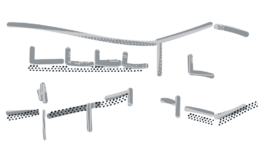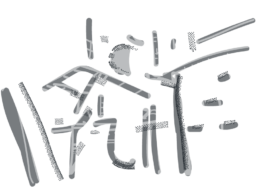How an underground energy network keeps the lights on across the Forty Acres, even in emergencies.
by Cody Bowie
It’s harder than you’d think to access a network of forbidden tunnels on the Forty Acres that reside just beneath our feet. And it’s easier than you’d imagine to access one of the largest microgrids in the United States.
The key to both is Xavier Rivera Marzán, the executive director of utilities and energy management at The University of Texas at Austin.


What do you notice?
Rivera Marzán says, gesturing to the glass wall that separates us from machinery within the Carl J. Eckhardt Combined Heat and Power plant (CHP). You might be imagining a dark, cramped space with leaky pipes — but what we encountered was just the opposite. It’s an open, multi-story space with a riot of heavy-duty equipment collectively pitching to a dull roar. Wooden crates sit toward the center of the room, denuded of their labels. Where there are colors, they are arresting — construction yellow, caution red, cerulean blue of a generator.
Lots of metal?
I say, because I am not an engineer. Wood?
He shakes his head.
It’s big?
I venture.
My colleague Jack threads the needle.
There aren’t any people.
Editor’s note: Don’t try this at home kids. Unauthorized entrance to the tunnel is prohibited; violators will be expelled and prosecuted.


Rivera Marzán nods, drawing us over to another room parallel to the plant but with fewer windows. Inside, someone sits at the helm of a computer surrounded by dozens of screens and readings that allow him to monitor the powerplant from nearby.
The University of Texas at Austin is one of a growing number of college campuses that are stepping up to the call for greater resiliency and developing microgrids to sustain their power needs. UT stands out from the pack because this system has powered our campus for close to a century.
Our first power plant was built in 1928 and its first generator was installed in 1929. Even then, the utilities management team saw what UT would become. They knew even then that we could not rely on the existing grid,
says Rivera Marzán. That we had to be self-sufficient. So, they invested in the power plant, they invested in a distribution system — the tunnels.
One of the largest microgrids in the United States, CHP is capable of generating 138 MW (megawatt) power (62 MW peak) and 1.2 million lb/hr (pounds per hour) of steam. The single largest electrical load on our main campus is the cooling system that can provide 60,600 tons (38,000 tons peak) of chilled water to the campus. Put simply, CHP provides all utility services to every building on the Forty Acres.
Rivera Marzán and his team ensure that mission critical services — like lab spaces, student dorms and classrooms — remain fully functional regardless of weather conditions. This remains a priority today, with Austin facing record-breaking winter storms and other major events in recent years. We have 79,000+ students, faculty and staff here. We have national research that happens here. We have Nobel Prize winners here. If you have a Nobel Prize winner that’s been working for 30 years on his research and all of a sudden you change the temperature because you don’t have power, you killed it. The services we provide are integral to the mission of this university.
Winter storms in 2021 tested CHP, but the lights stayed on. This proves that that investment that the university made back in the 1920s continues to be warranted,
Rivera Marzán says.


The Power Plant
When I asked for a tour of the tunnels that run beneath campus, I received an offer to tour Carl J. Eckhardt Combined Heat and Power plant instead. What drew me to the tunnels was their intrigue, their suggestion of the uncanny. I’d seen movies about what happens in tunnels beneath the Appalachians, beneath major cities. I’d read stories of bootleggers in the 1920s. There was so much to be uncovered — quite literally — under our feet.
What I didn’t expect was a lesson in energy, and how the tunnels are just one part of the vast network of machinery, people and systems that power our campus.
The University buys the water and gas it uses to create energy. The water moves through turbine generators to produce energy. Any exhaust collected from the turbines passes through a heat recovery steam generator (HRSG), to create heat that warms the water and makes steam. Then, that steam is used again to create more power — a process called cogeneration. This means that, instead of only being 60% efficient, CHP is close to 90% efficiency in power creation. In layman’s terms, this means that only 10% of the energy we buy is discarded as waste.
And below our feet, the series of tunnels, unspooling for miles, ferries this power and water across the Forty Acres. Built in the 1920s, the tunnels represent a feat beyond engineering — they’re also an example of a spirit of forward thinking that is a hallmark of UT’s utilities management team.
What happens when there’s a hurricane like Beryl that hit Houston, and all of a sudden you have these winds and all the electrical poles go down? Then there’s power outages,
Rivera Marzán said. We don’t have power outages here because it’s all underground. There could be any weather event above ground and there would be continuous protection of our distribution system since it’s underground.
So, there’s never an outage on campus?
I ask.
There are, of course. You guys never see it, but it happens. And that’s a good thing. If you guys don’t notice it, that means that we’re doing our job. The moment you notice, then my phone is ringing.


The Inner Sanctum
Rivera Marzán hands us squishy green ear plugs on a thin string. He leads us through the door into the power plant proper that we’ve been gazing at through the glass wall.
Our footsteps ring hollowly as we enter the room. We first experience a blast of heat, and then a roar of machinery. We push our earplugs in deeper and I say, loudly and obviously, I see why you monitor this from the other room! It’s hot in here!
The floor rings hollowly beneath our feet. We’ve stepped onto a large grate that encompasses much of the floor. Brief snatches of the level below flash before our eyes: flickering lights, more machinery, concrete flooring. Rivera Marzán leads us through the cavernous room, pointing out the combustion turbine and the heat recovery steam generator — both elephantine, filling the space with sound and heat and fury. A control terminal proudly states, Steam generator by Vogt in curled, mid-century font, although the generator is not that old — it was installed quite recently in 1987.
The room contains a mix of old and new that’s jarring. But it’s a mix that may just be the solution to providing energy to campus for lifetimes to come.
When I’m looking at utilities, I’m looking at it as a chess game,
Rivera Marzán says later, when we’ve left the plant sweating. And I have to be 15, 20 moves ahead. The decision I’m making now is going to impact us in 20 years and in 50 years.
The bishops on his chess board are the two boilers the University is currently replacing. The last time they were replaced? 1969. A World War II-era turbine generator also outfits the University with power. The longevity of these components necessitates forward thinking for utilities management, pushing the boundaries of the future of energy. I cannot think that the future for the next 50 years is going to be strictly natural gas. I need to be thinking forward and say, what’s going to be the replacement of fuel for this?
Hydrogen represents one intriguing option, and UT has already taken strides in bringing this energy source to the masses. Launched in 2020, the H2@Scale project aims to develop and demonstrate paths to renewable hydrogen as a clean and cost-effective fuel. And in 2024, the Center for Electromechanics, Frontier Energy and GTI Energy opened a first-of-its kind hydrogen research and demonstration facility.
We’re not just using our facilities to produce the utilities that we need as a university. We’re also using our facilities as a part of the University’s mission: learning, teaching and research,
says Rivera Marzán.
Utilities & Energy Management works with the Energy Institute at UT. Rivera Marzán regularly gives tours of the facility to lawmakers, students, professors — even visiting faculty from outside the United States. At the time of this interview, he was gearing up for a tour group of faculty from Japan.
I was in my third year as an engineer before I ever saw some of the equipment we use at the power plant in person. Most students and engineers work with symbols and diagrams early on. Here at UT, students can see the actual machinery behind those concepts — a boiler in action, not just a box labeled ‘B’ on a page.— Xavier Rivera Marzán, in an interview with Campus Operations
Ryan Thompson, director of operations at UEM, concurs. We receive some very unique and insightful questions from students during their visits,
he says. It’s inspiring to see the next generation of experts thinking in curious and innovative ways. As a former student here myself, I saw directly how helpful and educational seeing these plants can be.
I think a lot of people don’t know that we have a power plant here and they expect we’re connected to the ERCOT grid,
says Rivera Marzán. We’re connected as a backup, but we’re self-sufficient microgrid. Soon we’re going to have a water hub that will help us reclaim water.
Rapid growth across the Forty Acres and beyond bring exciting new challenges. Coming soon, the University of Texas at Austin Medical Center will increase campus square footage and require reliable utilities. And then there’s the satellite campuses that can fly under the radar in the minds of many Longhorns — the Pickle Research Campus, Montopolis Drive, and the newly acquired UT Taylor land that may one day host semiconductor research. What excites me is that ‘What Starts Here’ isn’t just a slogan. It’s real. What gets invented here, the research that happens here — it changes the world.


The Supernatural
Have you ever experienced anything supernatural in the tunnels? Anything you can’t explain?
I ask.
We’re sitting on a couch on the first floor of CHP. Rivera Marzán stops to think for a second and pulls out his phone. You know what?
he says. Let me call Leonard.
Leonard Friesenhahn arrives — tall, with a warmth and brusqueness that should feel at odds but don’t. A wide-brimmed fishing hat moves from his hand to his head. Rivera Marzán introduces him as the “owner of the tunnels,” but his real title is associate director of mechanical distribution for UEM. He has spent his entire 30-plus-year career at UT, with UEM for 23 years. He also has a B.S. from the Walker Department of Mechanical Engineering. He brags about remembering when tuition cost $3 a semester.
He’s a native Austinite who remembers coming to campus as a child with a relative who worked as a custodian at UT. He remembers being coming to the buildings at night to explore hidden nooks and crannies. He remembers how tunnel security changed after 9/11. He remembers the last time a student snuck into the tunnels — more than a decade ago — and how he surfaced to find a dozen state troopers, guns trained on his head.
Have you ever seen anything supernatural down in the tunnels?
Rivera Marzán repeats my question.
No,
Friesenhahn says flatly. I mean, we’ve seen animals in the tunnels. We’ve seen writing in the tunnels, scribbling from people who snuck in. There’s noises sometimes, but that’s steam and things moving around.
Nothing you can’t explain?
I press.
Nope,
Friesenhahn says.
We get to see things that a lot of people don’t get to see. There was somewhere, I can’t even remember if it was main building or whatever. There was this photo on the wall, or a painting. And no matter where you walked in the room, the eyes would follow you.
I ask him about my favorite urban legends. Do the tunnels below UT link to the Texas Capitol Complex? The Capitol has a tunnel system,
he says, but they don’t link.
Are the tunnels haunted? Just by raccoons.
Do the tunnels hide a confidential defense lab and supercomputer? At this, Friesenhahn just laughs.
But we must have struck a chord, been likeable or whimsical or idiotic enough, because Rivera Marzán asks Friesenhahn the million-dollar question: Can we take them down to see the tunnels?


Into the Tunnels
Friesenhahn takes us to another building, through a maze of restricted access doors. One, monitored at all times by UT security via camera, necessitated him calling and having a brief, tense conversation to get us access. When the last door finally opens, we find ourselves in a small, brightly lit room.
I have spent hours of my childhood huddling in dirt basements until tornados passed. I have crawled through the bowels of my high school after a meeting of the recycling club. I have walked among the millions upon millions of dead in the Paris catacombs.
This was nothing like that.
The lighting is harsh and yellow, leaving nothing to the imagination. Pipes of different sizes and shades of silver and rust unwind into faraway darkness, where we’re told not to photograph. Scribblings on the wall look like ancient cave drawings, except they’re notes made by utilities management staff members. Plastic red ribbons are tied off like tiny prayer flags on thin metal wires. A layer of thin dust films the walls.
Seeing it, it’s hard to imagine anything creepy going on down here. And it’s even harder to imagine that this small, cramped space that thousands of people walk above every day but will never see, keep our classrooms lit, our labs air-conditioned and our bathroom taps on.
“When we talk about sustainability with utilities, it’s not only the tree-hugging side. It’s being good stewards. It’s about the ‘sustain’ part of sustainability in order to be there in the long term. Are we going to be here in the next hundred years? Are we going to be here in the next 200 years? And how are we preparing for that future?”
— Xavier Rivera Marzán


Afterword: The History of Carl
Dear reader, this story would not be complete without a nod to the building’s namesake: Carl J. Eckhardt Jr.
Although many of us may not have heard of him, Carl J. Eckhardt Jr. (for whom CHP is named) is a Cockrell School legend. He was the first superintendent of the UT Austin Power Plant, a professor in the Walker Department of Mechanical Engineering whose tenure at the University spanned five decades, a prominent historian who wrote six books about UT Austin, an amateur botanist who planted numerous trees along Waller Creek, and the man responsible for starting one of the greatest traditions at UT Austin — the orange lighting of the Tower.
His life reads like something out of an adventure novel — a Scorpio born in 1902 to wealthy parents in Yorktown, Texas, his family lost their wealth in the economic crash of 1914. As a student at UT, he worked his way through college by waiting tables in a tearoom, then took a year off to work as a boiler fireman in the oil fields of Luling, Texas. He returned to UT Austin as a student assistant in 1924, and obtained his bachelor’s degree in mechanical engineering in 1925. He went on to obtain his master’s degree in 1930 and became a mechanical engineering professor in 1936. Later, he became the superintendent of utilities at UT.
Would you like to know more?
Learn more about the Carl J. Eckhardt Combined Heating and Power Complex and Eckhardt himself.